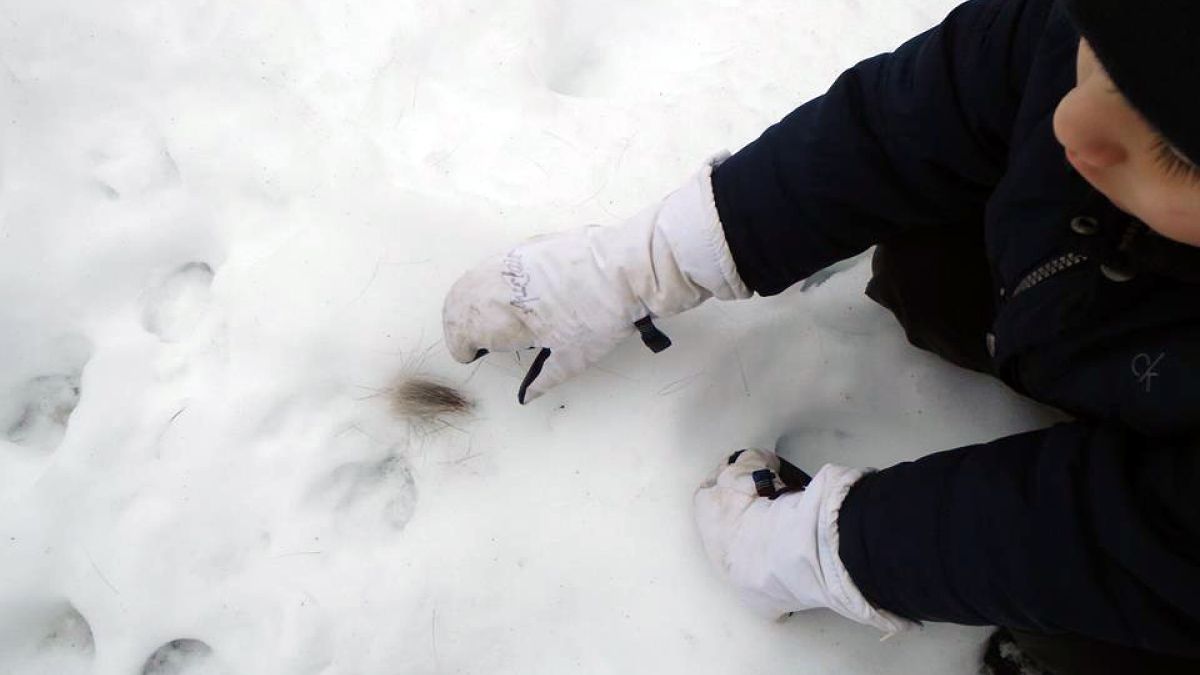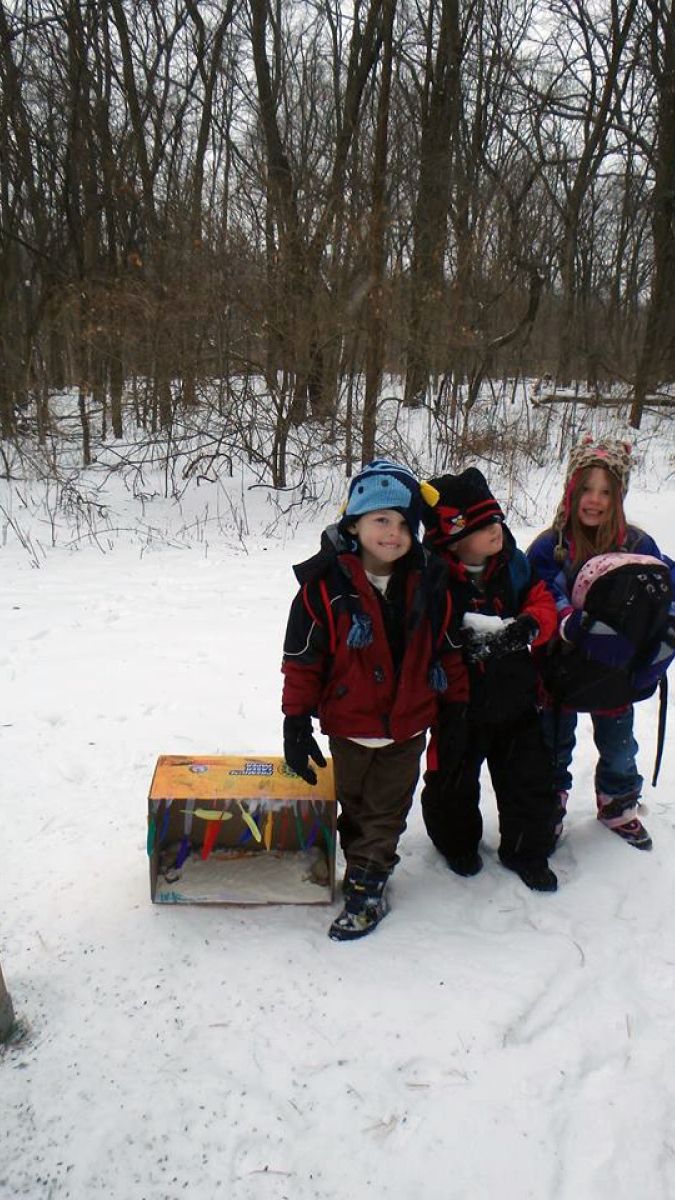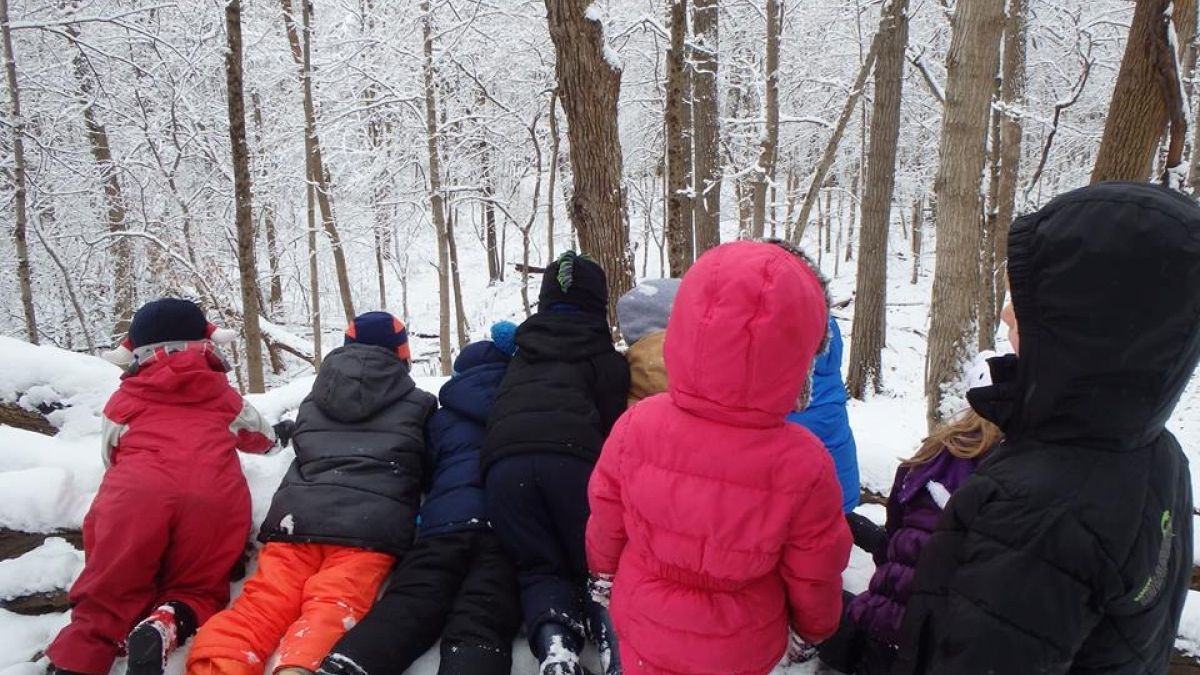
Tromping through the woods on a brisk, snowy morning in northern Illinois with a dozen red-cheeked, bright-eyed 4-year-olds was just the beginning of another day at nature preschool. We were following a set of deer tracks through the woods and across a creek when we startled the deer we had been tracking. We watched silently as the deer lifted their white tails and bounded away. I saw the children’s eyes dancing and could just make out their excited faces underneath their hats and scarves. We continued to stand in still silence for a moment even after the deer had gone. It was a moment to savor, to reflect, to imprint upon their memory.
We didn’t know it then, but it was also a moment that sparked a weeks-long project that would build the children’s understanding of sensory experiences, refine their critical thinking, and test their determination.
Young Animal Trackers

My students had been learning about animal tracks for a couple of weeks and they were excited to find such a variety of clear prints in the fresh snow. They enjoyed following tracks through the hundreds of acres at our forest preserve. They took tracking guides with them as they discovered beaver, vole, rabbit, coyote, squirrel, opossum, and deer tracks. They talked about how fast the animal might have been going and how big it may have been. Then they hypothesized about what the animal was doing and where it was going and they even talked about how the animal may have been feeling.
After the children had this inspirational moment with the deer, they began hatching an idea to “collect” some tracks for themselves. I wondered aloud how we could do that. This sparked an excited and creative discussion. The children deliberated digging up a snowy track to bring to the classroom, but they decided that it wouldn’t work because it would melt. They continued to brainstorm possibilities for track collecting as we hiked back to the classroom. Their last idea was to lure animals into a box where they would leave their tracks on the floor of the box. The details were sketchy, but the core idea was sound.
Building a Bait Box
I rolled with this concept, and the next day I placed boxes of varying sizes and several different materials out in the classroom. Much like the pragmatic philosophy of John Dewey, I, too, feel that children have active and inquisitive minds. They do not simply receive knowledge through instruction, but they make it as they interact with the environment. To facilitate this, I allowed the children the opportunity to do whatever they wanted with the materials as long as they worked in teams to prepare what we would soon call a “bait box.”

One group of students wanted to attract mice into a small bait box. I observed them discussing their planning strategies. They glued feathers to the top of the box that would hang down over the open side and “tickle” the mice as they entered the box. They reasoned that it would make the mice happy to come into the box. In fact, it would make them so happy that they would walk in and out of the box several times so that they could be tickled over and over. Then those same happy mice would tell all of their mice friends to come to the box as well. They drew pictures of happy mice on the sides of the box to depict a “mouse party.” They gathered up and placed a lump of comfy cotton inside the box for a cozy resting spot after the mice were tired from all of the tickling. They also placed a small tray of seeds in the corner. These children were using their personal sensory experiences as a guide for what the mice would enjoy. They recognized the value of sensorial connections.
The other group of children included sensory enticements in their bait box as well. They were trying to lure a raccoon into their box, so they used bright red and yellow feathers scattered on the bottom of the box to simulate a dead chicken and they requested stinky tuna to appeal to a raccoon’s sense of smell. They never explained how they knew that a raccoon would be enticed by a dead chicken and stinky tuna, but I obliged and brought in tuna the very next day. To collect the animal tracks, both groups of children decided to cover the bottom of the box in flour.
Testing and Testing Again, and Again
The boxes yielded few, if any, tracks despite the effort and ingenuity. The lack of tracks did not discourage the children and they were still highly engaged as they revamped the sensory enticements, box placement, and tracking substrate. The bait box project went on for several weeks as the children were determined to find the perfect combination for collecting their tracks. They were using their critical thinking skills and learning through trial-and-error.
Eventually, the mouse bait box was placed under the birdfeeder where the children had seen other mice tracks, and the raccoon bait box was placed deep in the woods near the creek where the children thought a raccoon might go to look for fish. This final attempt yielded success for both bait boxes on the same day. When the children discovered the animal tracks, there were whoops of joy and hand slapping. Their exuberance could not be contained and they were on cloud nine for several weeks.
Sensory Experiences Guide Learning

This organic project yielded so many opportunities for growth and development for each student. The many different skill-building connections that this simple, yet complex, activity provided astounds me, and yet this project was child-led with only me and my aide as fellow explorers to support or guide through asking open-ended questions.
The children were observing, hypothesizing, communicating, negotiating, collaborating, sharing knowledge, thinking critically and abstractly, learning cause-and-effect, experimenting, showing sympathy, developing self-confidence, taking initiative, solving problems, making decisions, persevering, and showing grit and determination. All of these skills will help these children become life-long learners.
The children were only 4 years old, but they used their own experiences of sensory stimuli to provide just the right sensory attractions for the animals. Using sensory experiences to encourage learning is what nature-based education is all about—allowing the students to construct their own knowledge by working through experiences that ensnare the heart, mind, and body of the child, blending play, love, and work.
It is not half so important to know as to feel. If facts are the seeds that later produce knowledge and wisdom, then the emotions and the impressions of the senses are the fertile soil in which the seeds must grow. The years of early childhood are the time to prepare the soil. Once the emotions have been aroused—a sense of the beautiful, the excitement of the new and the unknown, a feeling of sympathy, pity, admiration or love—then we wish for knowledge about the subject of our emotional response. Once found, it has lasting meaning. It is more important to pave the way for the child to want to know than to put him on a diet of facts he is not ready to assimilate.
-Rachel Carson, Sense of Wonder
About the Author
Megan Gessler is Manager and Lead Teacher at Natural Beginnings Early Childhood Program in Yorkville, Illinois. She is also the President of the Northern Illinois Nature Preschool Association. Having spent much of her youth camping and exploring with her family, she now enjoys introducing her own two children and her students to the wonders of the outdoors. Gessler is currently pursuing her master’s degree at Antioch University New England where she is strengthening her educational foundation for nature-based programming.